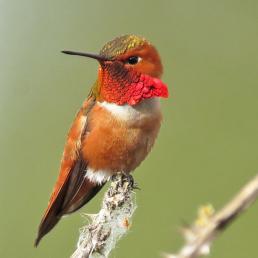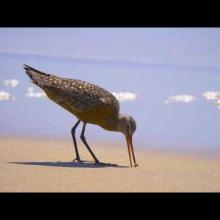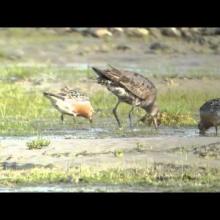

Join BirdNote tomorrow, November 30th!
Illustrator David Sibley and actor H. Jon Benjamin will face off in the bird illustration battle of the century during BirdNote's Year-end Celebration and Auction!
It's September, and millions of shorebirds are on the move. Most nest in high northern latitudes, such as the Arctic tundra. And a surprising number fly all the way to South America. This young Hudsonian Godwit might have hatched near Hudson Bay or in extreme northwest Canada, and it will probably winter in southeastern South America - maybe as far south as Tierra del Fuego!
Listen to this episode in Spanish here.
BirdNote®
Shorebirds Migrate South - Where Are They Bound?
Written by Bob Sundstrom
This is BirdNote.
[Hudsonian Godwits and Black-bellied Plovers calling]
In September, all across North America, the southward migration of shorebirds reaches its peak. Millions of shorebirds – the sandpipers and plovers that grace our shorelines – are on the move. And many birders now flock to the mudflats to watch the annual pilgrimage.
Most shorebirds nest in high northern latitudes, such as the Arctic tundra. Where are these migrants bound?
A surprising number fly all the way to South America. Hudsonian Godwits, [Hudsonian Godwits calling] which hatch their young near Hudson Bay and in extreme northwest Canada, winter in southeastern South America – some as far south as Tierra del Fuego. [Hudsonian Godwits calling] Lovely American Golden-Plovers fly similar distances [American Golden-Plovers calling]. Some log nearly 20,000 miles in their annual circuit from the Argentine Pampas to the Arctic and back.
[American Golden-Plovers calling]
The beautiful Black-bellied Plover, [Black-bellied Plover calls] which also nests in the far north, has a very different migratory strategy. [Black-bellied Plover calls]
Wintering primarily on coastal beaches and mudflats, Black-bellied Plovers spread themselves out for the colder months all the way from the Canadian border to central South America. [Black-bellied Plover calls]
If you'd like a chance to see and hear a multitude of incredible bird species in Cuba, why not join BirdNote on our trip to the island this fall? Spaces are limited, so look for more details today at BirdNote.org. The trip to Cuba was in 2014.
For BirdNote, I’m Michael Stein.
###
Bird audio provided by The Macaulay Library at the Cornell Lab of Ornithology, Ithaca, New York. Hudsonian Godwit calls recorded by G.A. Keller and W.W.H. Gunn. Black-bellied Plover calls recorded by R.C. Stein. American Golden-Plover recorded by G. Vyn.
Ambient waves by Kessler Productions.
BirdNote’s theme music was composed and played by Nancy Rumbel and John Kessler.
Producer: John Kessler
Executive Producer: Dominic Black
© 2014 Tune In to Nature.org September 2014 Narrator: Michael Stein
ID# shorebird-02-2008-09-04 shorebird-02b






